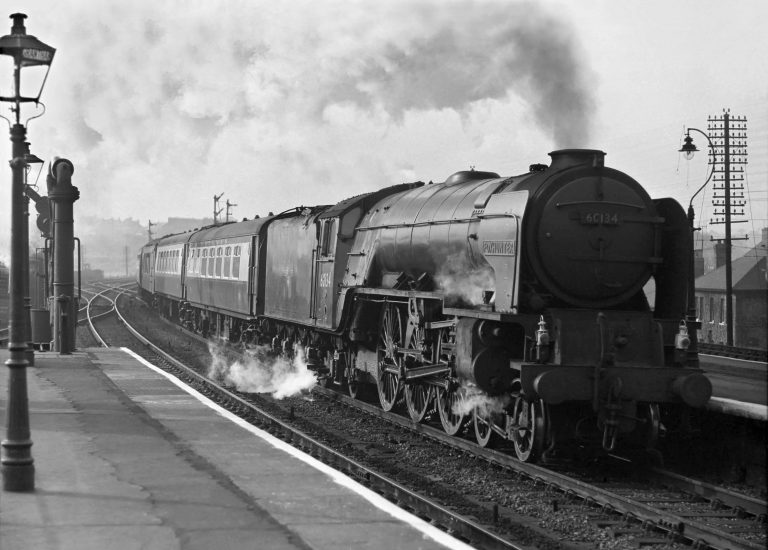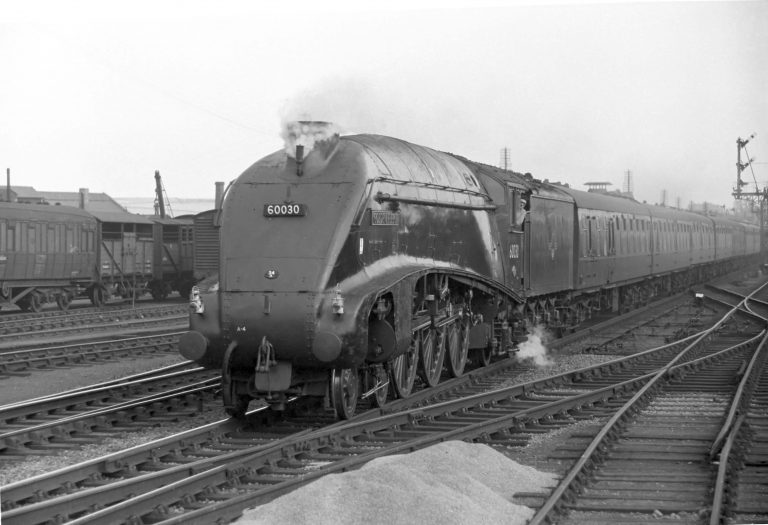We have added some new content to our 'Diesel Era' pages, this time looking back to the late 1950s, when as part of their modernisation plan, British Railways carried out a series of main line tests with a prototype diesel electric locomotive - ‘Deltic’ which had been built by English Electric. The production fleet that followed as a result of these tests came into operation from 1961 onwards, taking over a variety of steam hauled services. They were initially numbered D9000 to D9021 and transformed express services to and from London King’s Cross along the ECML. Later they were renumbered with the class prefix - 55, but we still referred to them as 'Deltics'. Our aim here is to only provide a brief potted history of the class, thus providing a starting point for specific 'Grantham related' 'Deltic' stories that will follow in the future. You can read more here.
News
A Spearmint Double
Edinburgh Haymarket-based A3 60100 Spearmint was a bit of a rare sight as far south as our Tracks through Grantham territory, so when the locomotive turned up in two separate stories recently sent in by Alan Wilce and Roger Bamber we were tempted to rename 60100 as Doublemint! However, having chewed it over, we decided to keep things as they were, so hopefully our two new pages in 'Spotters’ Corner' from Roger and Alan will bring a breath of fresh air for our readers.
So join 13-year-old Roger Bamber on Grantham station in 1958, having travelled by bike over the hilly A607 from Leicester. When opportunities arise to capture some Haymarket Rarities on film, Roger is ready with his camera. One of the images is a photograph that helped to determine his career.
Then join Alan Wilce in 1960. Alan arrived from Melton Mowbray in his parents' car. His records were taken with pencil and notepad rather than film and now, with his Ian Allan ABC 'Combined Volume', his memories and some archive timetables, Alan re-creates for us the excitement of a 3-hour Summer Evening Visit to Grantham in 1960 during which 60100 Spearmint made another rare appearance at the station.
Let’s take a trip to Tyneside on the footplate of an A4 – and back home on an A3!
We've said before that often we don't know where the inspiration for the next new page for Tracks through Grantham will appear from. We have items 'in the pipeline' all the time but, quite regularly, someone will get in touch with a surprise discovery. Just a few weeks ago a copy of a magazine titled Locomotive Express revealed a previously unknown (to us) account of a regular day's work for a No. 1 Express Link crew at Grantham Loco in 1950.
So prepare to get grit in your hair, and organise a nice warm bath for when you get home, as we travel 326 miles in one shift with a Grantham crew on our latest page All in a Day's Work.
Getting Started – Grantham station’s Train Starting Indicator
Our latest page explores a little-known piece of equipment on Grantham station.
A New Hat for Peascliffe Tunnel
Above: Peascliffe Tunnel as depicted on the 1903 six-inch OS map, with the ventilation shaft indicated.
Jeff Thompson has always kept a close eye on the railway, especially in the Peascliffe area. Last Wednesday, 30th September, among the trees above the tunnel, work was taking place on the brick chimney above the ventilation shaft:

Photograph by Jeff Thompson.
Yesterday, the smart new cover was in place:

Photograph by Jeff Thompson.
Jeff says "All ready for Royal Ascot Ladies Day!! There's a very different sound from passing trains, but I haven't yet heard a 'Streak'."
Grantham Driver ‘Sam’ Pearce
In October 2019 we published a page of photographs taken by Colin Walker when he was a guest on the footplate of an O2 locomotive during a wintry trip from Grantham up to Highdyke Yard, A Trip to Highdyke in Winter's Chill. The driver that day was 'Sam' Pearce.
Sam's grandson, Chris, has recently been in touch to share some memories of his grandfather Sam - a name which, in common with at least one other driver at Grantham known as 'Sam', wasn't actually his real name as you'll discover when you turn to our latest new page.
Great Ponton Signal Box
Hello everyone. When we launched Tracks through Grantham in the summer of 2016 the focus was necessarily on the railway in the vicinity of Grantham station. Over time our scope has extended south to Stoke Summit to include Stoke Signal Box and Highdyke Yard. Our latest page covers the signal box at Great Ponton. We hope you'll find it an enjoyable and interesting read. If you'd like to send us some feedback please leave a comment.
In future we would like to include more about the station at Great Ponton, so if you have information, photographs or memories that would help to fill out its story, or you know someone who has, please get in touch, using the Contact Form on our Contact Us or Subscribe page.
John Clayson & Mel Smith
Two New Signal Box Pages
The coverage of signalling in the Grantham area on Tracks through Grantham has recently extended north and south with new pages about Barrowby Road and Saltersford signal boxes.
Grantham Spotting Notes & Tales

The photograph we show here might be a bit hazy, but we are sure you will agree that our fond memories of those bygone days seem to get even sharper as we advance in years and it's often the case that we soon forget more recent times. Keeping that thought (hopefully) in mind and maybe having stirred up some of your own memories, we would like to invite you to tell us about your days spent 'spotting' at Grantham Station.
We are currently gathering information and anecdotes for a series of future articles about trainspotting at Grantham, especially during the late 1950s and early 1960s. We are also putting together a separate article that will look at typical passenger, freight and parcels workings through Grantham, specifically focussing on the 1961 Summer Timetable. If you have spotting notes, amusing tales, personal recollections or even photographs from the above era, please do get in touch. Your memories, notes and surviving jottings will help us to record and once again bring alive those halcyon days.
Please visit the Contact or Subscribe page here
RAIB Report on a ‘near-miss’ incident at Edinburgh Waverley on 1st August 2019: remarkable similarities to the Grantham disaster of September 1906
Last December a News item, copied below, appeared on Tracks through Grantham. Yesterday the Rail Accident Investigation Branch (RAIB) published its report on an incident at Edinburgh last August which makes very interesting reading when considered in the context of the high speed derailment at Grantham in September 1906.
In the conclusions of his report on the 1906 Grantham disaster the Board of Trade Inspector discounted a problem with brake control or effectiveness as the likely, or even as a possible, cause of the accident. In fact the report was inconclusive as to the cause of the disaster. Nevertheless, it has since become generally accepted that - as some suspected at the time - the accident resulted from failure to properly connect and test the automatic brake at Peterborough immediately prior to the train’s departure. It also seems certain that a running brake test, which should have been conducted once the train got under way, either was not implemented or had been insufficiently rigorous to identify a serious lack of brake effectiveness.
It’s remarkable how comparable the circumstances were in Scotland last August. By good fortune, and through the availability of modern communication systems, a tragic outcome was avoided that morning. During the enquiry the evidence of the driver and the other members of the train crew, along with comprehensive data logging, enabled the sequence of events which led to the incident to be identified with certainty.
Conversely, following the 1906 Grantham disaster, in which the footplate crew were killed (along with 12 others) and most of the train was severely damaged by impact and fire, there was little hard evidence to prove or dispute the several theories put forward. If only GNR Atlantic No. 276 could have been equipped with an On Train Data Recorder!
The recently published report can be found on the RAIB website here.
Thanks to Phil Mason of the Grantham Railway Society for making us aware of the report.
(December 2019)
In his column in the current (December 2019) issue of The Railway Magazine Consultant Editor Nick Pigott has picked up on a striking similarity between the most likely cause of the disaster at Grantham on the night of 19th September 1906, when 14 lives were lost, and the lead-up to an alarming incident which took place at Edinburgh Waverley station on 1st August this year.
In both cases the locomotive had been attached at an intermediate stop on the train's journey. Each train then seriously overran its next stopping point, apparently because the train's braking system was not properly connected to the locomotive.
In the Grantham 1906 accident the overrunning train derailed at high speed on a junction which began 135 yards beyond the platform. Fortunately, at Edinburgh in 2019 the train involved was brought to a stand using a manually activated emergency system without collision or derailment, having travelled 650 metres beyond its intended stopping point.
Further reading:
- Multiple Aspects with Nick Pigott in The Railway Magazine December 2019, page 12
- the Grantham 1906 accident: Grantham North signal box - people and incidents
- the Edinburgh Waverley 2019 incident: Rail Accident Investigation Branch (RAIB) website



